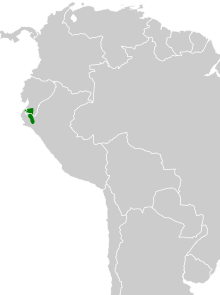| Grey-headed antbird | |
|---|---|
| Conservation status | |
 Vulnerable (IUCN 3.1) | |
| Scientific classification | |
| Domain: | Eukaryota |
| Kingdom: | Animalia |
| Phylum: | Chordata |
| Class: | Aves |
| Order: | Passeriformes |
| Family: | Thamnophilidae |
| Genus: | Ampelornis Isler, Bravo & Brumfield, 2013 |
| Species: | A. griseiceps |
| Binomial name | |
| Ampelornis griseiceps (Chapman, 1923) | |

| |
| Synonyms | |
|
Myrmeciza griseiceps | |
The grey-headed antbird (Ampelornis griseiceps) is a Vulnerable species of bird in subfamily Thamnophilinae of family Thamnophilidae, the "typical antbirds". It is found in Ecuador and Peru.
Taxonomy and systematics
The grey-headed antbird was described by the American ornithologist Frank Chapman in 1923 and given the binomial name Myrmoderus griseiceps. It was later placed in genus Myrmeciza but a molecular phylogenetic study published in 2013 found that the genus Myrmeciza, as then defined, was polyphyletic. In the resulting rearrangement to create monophyletic genera, the gray-headed antbird was moved to a newly erected genus Ampelornis. The name combines the Ancient Greek words ampelos "vine" and ornis "bird". The genus is monotypic.
Description
The grey-headed antbird is 12.5 to 13.5 cm (4.9 to 5.3 in) long and weighs about 15 g (0.53 oz). Adult males have a gray head, neck, and mantle. The rest of their upperparts are olive-brown with a white patch between their scapulars. Their flight feathers are dark brownish gray with pale brown edges; their wing coverts are black with wide white tips. Their tail is dark brownish gray with white tips on the feathers. Their center of their lower throat and breast are black, the rest of their breast and belly are gray, and their flanks, vent area, and undertail coverts are olive-brown. Adult females have a paler gray head than males. Their throat and breast are streaked gray or olive-gray on white and their belly is whiter than the male's. Their back and the rest of their underparts are like the male's. Subadult males resemble adult females.
Distribution and habitat
The grey-headed antbird is found from far southwestern Ecuador's El Oro and Loja provinces into northwestern Peru as far as the departments of Lambayeque and Cajamarca. It inhabits the understorey of montane evergreen forest and the ecotone between it and deciduous forest. It is often associated with bamboo but not confined to it. In elevation it ranges between 600 and 2,500 m (2,000 and 8,200 ft) in Ecuador and 700 and 2,900 m (2,300 and 9,500 ft) in Peru.
Behavior
Movement
The grey-headed antbird is believed to be a year-round resident throughout its range.
Feeding
The gray-headed antbird feeds primarily on insects and probably includes other arthropods in its diet. Individuals, pairs, and family groups forage in dense vegetation, usually between 2 and 7 m (7 and 23 ft) above the ground. It hops and makes short flutter-flights between perches and takes prey by gleaning from leaves, stems, and vines. It sometimes joins mixed-species feeding flocks.
Breeding
The gray-headed antbird's breeding season appears to be from January to May but nothing else is known about its breeding biology.
|
Songs and calls Listen to the grey-headed antbird on xeno-canto |
Vocalization
The grey-headed antbird's song is "a short, rapid, descending series of churred notes: CHEER'R'r'r'r'r'ew" and its call "a harsh, whining rheer-rhurr".
Status
The IUCN originally in 1988 assessed the grey-headed antbird as Threatened, then in 1994 as Endangered, and since 2000 as Vulnerable. It has a somewhat limited range and its estimated population of between 2500 and 10,000 mature individuals is believed to be decreasing. "Significant habitat loss is ongoing, at least in unprotected areas, and will soon remove almost all extant lowland forest unless effective action is taken urgently." It is considered rare to uncommon throughout its range. It is known from one protected area in each country. "Further investigation into its ecology would help to clarify its true micro-habitat needs, particularly with respect to the relative importance of bamboo; this could influence decisions on habitat preservation and management."
References
- ^ BirdLife International (2016). "Grey-headed Antbird Ampelornis griseiceps". IUCN Red List of Threatened Species. 2016: e.T22701847A93851450. doi:10.2305/IUCN.UK.2016-3.RLTS.T22701847A93851450.en. Retrieved 5 August 2024.
- ^ Gill, Frank; Donsker, David; Rasmussen, Pamela, eds. (January 2024). "Antbirds". IOC World Bird List. v 14.1. Retrieved 4 January 2024.
- Chapman, Frank M. (1923). Descriptions of proposed new Formicariidae and Dendrocolaptidae. American Museum Novitates. New York: American Museum of Natural History. p. 6. hdl:2246/4633.
- ^ Isler, M.L.; Bravo, G.A.; Brumfield, R.T. (2013). "Taxonomic revision of Myrmeciza (Aves: Passeriformes: Thamnophilidae) into 12 genera based on phylogenetic, morphological, behavioral, and ecological data" (PDF). Zootaxa. 3717 (4): 469–497. doi:10.11646/zootaxa.3717.4.3. PMID 26176119.
- ^ Zimmer, K. and M.L. Isler (2020). Gray-headed Antbird (Ampelornis griseiceps), version 1.0. In Birds of the World (J. del Hoyo, A. Elliott, J. Sargatal, D. A. Christie, and E. de Juana, Editors). Cornell Lab of Ornithology, Ithaca, NY, USA. https://doi.org/10.2173/bow.gyhant1.01 retrieved August 5, 2024
- ^ Ridgely, Robert S.; Greenfield, Paul J. (2001). The Birds of Ecuador: Field Guide. Vol. II. Ithaca: Cornell University Press. p. 425. ISBN 978-0-8014-8721-7.
- ^ Schulenberg, T.S., D.F. Stotz, D.F. Lane, J.P. O’Neill, and T.A. Parker III. 2010. Birds of Peru. Revised and updated edition. Princeton University Press, Princeton, New Jersey. Plate 169.
External links
| Taxon identifiers | |
|---|---|
| Myrmeciza griseiceps | |

